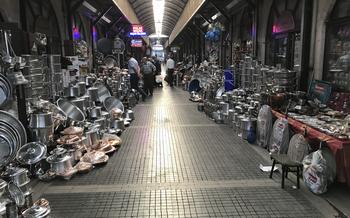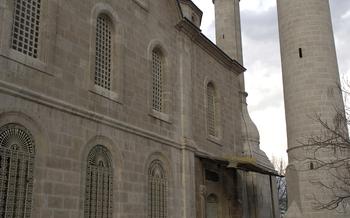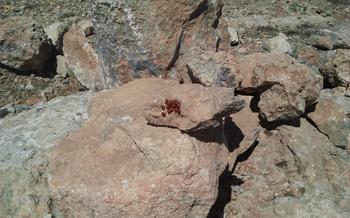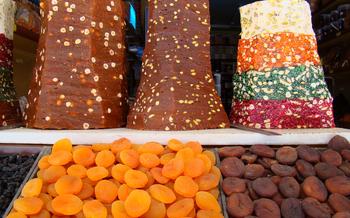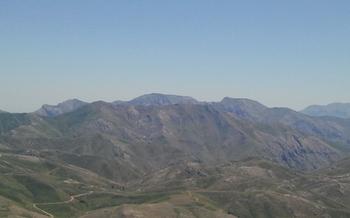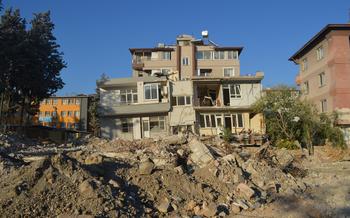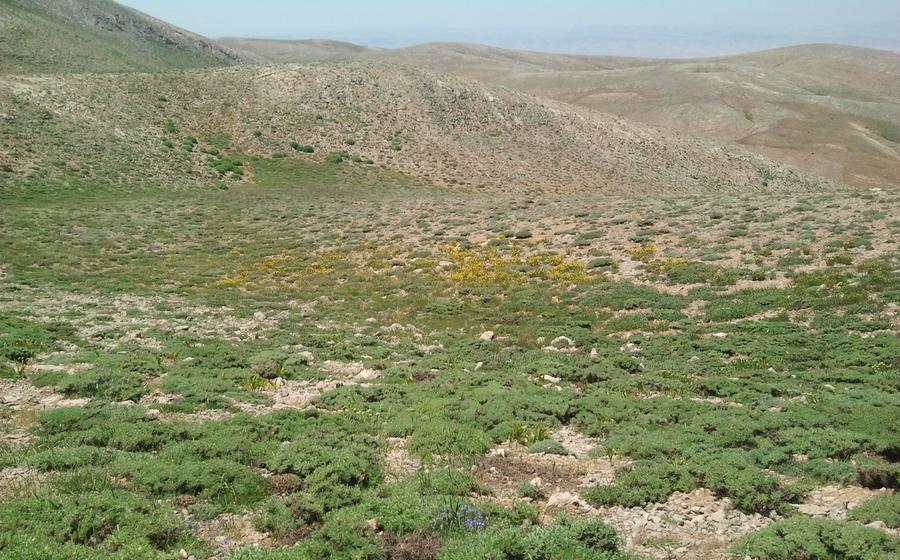
Palu Grand Mosque (Near Malatya)
- A Journey to Palu Grand Mosque
- History and Significance
- Architectural Features and Design
- Personal Experience
- A Bridge Between Civilizations
- Guardians of Time
- Divine Grandeur
- A Place of Worship and Community
- A Symbol of Harmony
- A City of Historic Treasures
- A Culinary Adventure
- Off the Beaten Path
- The Warmth of Turkish Hospitality
- A Photographer's Paradise
- A Journey Through Time
- A Reflection of Faith
- The Sounds of History
- The Call to Prayer
- Music and Arts: Inspired by Tradition
- Personal Anecdotes
- Tips for Travelers
- Insider Tip:
A Journey to Palu Grand Mosque
Standing majestically amid the vibrant city of Malatya, the Palu Grand Mosque beckons travelers with its rich history and spiritual allure. Built in the 12th century during the reign of the Artuqid dynasty, this architectural masterpiece reflects the fusion of Islamic and Byzantine influences that have shaped the cultural tapestry of Anatolia. The mosque's significance extends beyond its religious function, serving as a symbol of unity, resilience, and artistic brilliance.
History and Significance
The Palu Grand Mosque bears witness to the rise and fall of empires and the ebb and flow of civilizations. Constructed by the Artuqid dynasty, who ruled over southeastern Anatolia from the 11th to the 15th century, the mosque stands as a testament to their architectural prowess and devotion to Islamic traditions. Over the centuries, it has undergone renovations and additions, each reflecting the changing artistic styles and beliefs of successive rulers.
Architectural Features and Design
The mosque's architectural design showcases a harmonious blend of Islamic and Byzantine elements. The courtyard, a defining feature of Islamic architecture, provides a serene space for contemplation and gathering. The prayer hall, with its rows of arches supported by massive columns, exudes an aura of grandeur and spirituality. The exterior is adorned with intricate tilework and calligraphy, showcasing the artistic mastery of the period.
Personal Experience
Visiting the Palu Grand Mosque was a profound experience that transported me back in time. As I stepped through the ancient gateway, I was enveloped by a sense of awe and reverence. The intricate carvings, the soft echoes of prayers, and the palpable energy of centuries of worship created an atmosphere of deep spirituality. It was a privilege to witness the enduring legacy of this architectural masterpiece and to feel the vibrant pulse of faith that continues to resonate within its walls.
A Bridge Between Civilizations
The Palu Grand Mosque stands as a testament to the rich cultural fusion that has shaped the region throughout history. Blending Islamic and Byzantine architectural elements, the mosque reflects the diverse influences that have left their mark on Malatya. The city's strategic location on trade routes contributed to this cultural exchange, as people from different backgrounds and faiths converged here, sharing ideas and traditions.
One of the most striking features of the mosque is its blend of architectural styles. The pointed arches, domes, and minarets are reminiscent of Islamic architecture, while the use of stone and the intricate carvings bear the hallmarks of Byzantine influence. This fusion of styles symbolizes the harmonious coexistence of different cultures in Malatya, showcasing the city's role as a bridge between civilizations.
Anecdotes abound of cultural exchange and mutual respect among the diverse communities that have called Malatya home. The city's rich history is filled with stories of collaboration, intermarriage, and the sharing of knowledge and traditions. The Palu Grand Mosque stands as a living testament to this spirit of unity and understanding, a reminder that dialogue and cooperation can create a vibrant and harmonious society.
Guardians of Time
The Palu Grand Mosque has stood the test of time, defying the ravages of earthquakes and invasions. Its resilience is a testament to the enduring spirit of the people of Malatya.
In 1894, a devastating earthquake shook the region, leaving widespread destruction in its wake. Miraculously, the mosque suffered only minor damage, a testament to its robust construction. The faithful saw this as a sign of divine protection, reinforcing their belief in the mosque's sacred significance.
Throughout history, the mosque has also faced the threat of invasion. During the Mongol invasion of the 13th century, the mosque was spared destruction due to the intervention of a local Sufi saint, who convinced the Mongol commander to spare the holy site.
In the 20th century, the mosque underwent extensive restoration efforts, meticulously preserving its architectural integrity. This dedication to preserving the mosque's heritage ensures that it will continue to stand as a symbol of faith and resilience for generations to come.
The stories of the mosque's endurance are passed down through generations, reminding the people of Malatya of their rich history and the importance of preserving their cultural heritage. The Palu Grand Mosque stands as a testament to the enduring power of faith and the resilience of the human spirit.
Divine Grandeur
The Palu Grand Mosque stands as a testament to the grandeur of Islamic architecture. Its sheer size and awe-inspiring dimensions evoke a sense of reverence and tranquility. The spacious courtyard, meticulously adorned with intricate tilework and calligraphy, invites visitors to pause and appreciate the beauty that surrounds them. The graceful minarets, reaching towards the sky, symbolize the mosque's connection to the heavens.
As I stepped into the mosque's courtyard, I couldn't help but be struck by its sheer scale. The expansive space, framed by elegant arches and columns, created an atmosphere of serenity and contemplation. The intricate tilework, featuring vibrant shades of blue, green, and gold, adorned the walls and ceilings, adding a touch of opulence to the sacred space. The calligraphy, inscribed in flowing Arabic script, whispered verses from the Quran, reminding visitors of the mosque's religious significance.
The minarets, towering over the city skyline, were a testament to the mosque's grandeur. Their slender forms, adorned with intricate carvings and delicate balconies, seemed to reach for the heavens, connecting the earthly realm with the divine. From the base to the tip, every detail of the mosque's architecture spoke of the skill and devotion of its builders.
The Palu Grand Mosque is not just a place of worship; it is a masterpiece of Islamic art and architecture. Its grandeur and beauty are a testament to the rich cultural heritage of Malatya and a reminder of the enduring power of faith.
A Place of Worship and Community
The Palu Grand Mosque is not just a place of worship but also a vibrant community center. Throughout the day, the mosque echoes with the sounds of prayer, as locals gather to perform their daily religious obligations. These prayers are not mere rituals; they are expressions of a deep connection with the divine, a connection that unites the community in a shared spiritual experience.
Beyond prayers, the mosque plays a crucial role in shaping local traditions and fostering a sense of togetherness. It hosts community events, celebrations, and gatherings, where people from all walks of life come together to share their joys, sorrows, and aspirations.
I had the privilege of attending one such gathering—a traditional Turkish coffee ceremony held in the mosque's courtyard. As the aromatic coffee was brewed and served, the atmosphere was filled with laughter, chatter, and the warmth of human connection. It was a beautiful display of how the mosque serves as a bridge between the spiritual and the social, enriching the lives of the community members.
A Symbol of Harmony
Malatya stands as a testament to the harmonious coexistence of different faiths, with the Palu Grand Mosque serving as a symbol of unity and respect among religious communities. Muslims, Christians, and Jews have lived side by side in this city for centuries, fostering an environment of mutual understanding and cooperation.
As I strolled through the streets of Malatya, I couldn't help but notice the absence of religious tension. People from all walks of life interacted with each other with warmth and kindness, regardless of their religious beliefs. The mosque itself seemed to embody this spirit of harmony, with its open doors welcoming worshipers of all faiths.
During my visit, I had the privilege of meeting with a local Christian family who shared stories of their deep-rooted friendship with Muslim neighbors. They spoke of shared celebrations, acts of kindness, and a sense of community that transcended religious differences.
The Palu Grand Mosque stands as a testament to the power of religious tolerance and understanding. It is a place where people of different faiths come together to celebrate their shared humanity, setting an example for peaceful coexistence in a world often divided by religious conflicts.
A City of Historic Treasures
Malatya is a city steeped in history, with a rich tapestry of ancient ruins, castles, and museums that tell the story of civilizations past. One of the most prominent historical sites is the Malatya Museum, which houses an impressive collection of artifacts from the Neolithic period to the Ottoman era. Visitors can marvel at intricate pottery, bronze sculptures, and ancient manuscripts that provide a glimpse into the region's rich cultural heritage.
Among the must-see historical sites is the majestic Malatya Castle, a formidable fortress that has stood witness to the rise and fall of empires. Built in the 4th century BC, the castle offers stunning panoramic views of the city and the surrounding countryside. Its imposing walls and towers evoke a sense of awe, transporting visitors back in time to an era of chivalry and conquest.
For those interested in exploring the city's religious history, the Armenian Church of Surp Sarkis is an architectural gem that showcases the region's diverse religious heritage. Built in the 19th century, the church features intricate carvings, colorful frescoes, and a serene atmosphere that invites contemplation and reflection.
To delve deeper into the region's past, visitors can explore the Aslantepe Mound, an archaeological site that has yielded significant findings from the Hittite period. The excavations have unearthed impressive fortifications, royal tombs, and cuneiform tablets that shed light on the advanced civilization that once thrived in this area.
Tips for Exploring Malatya's Historical Sites:
- Plan your visit during the spring or fall to enjoy pleasant weather and avoid the summer crowds.
- Wear comfortable shoes as you'll be doing a lot of walking.
- Allocate sufficient time to explore each site, as they offer a wealth of history and cultural significance.
- Take advantage of local tour guides who can provide insights and anecdotes that bring the sites to life.
- Be respectful of local customs and traditions when visiting religious or historical sites.
A Culinary Adventure
Malatya is not just a city of historical wonders; it's also a culinary paradise. The region is renowned for its sweet and succulent apricots, which are celebrated each year with a vibrant Apricot Festival. Indulge in the delectable taste of these sun-kissed fruits, savored both fresh and transformed into jams, preserves, and other delightful treats.
Beyond apricots, Malatya offers a tantalizing array of local dishes that reflect the city's rich cultural heritage. Traditional Turkish cuisine takes on a unique regional twist, blending flavors and ingredients from neighboring regions. Savor the aromatic "Malatya Tavası", a hearty lamb stew cooked in a clay pot, or tempt your taste buds with "Malatya Mantısı", delicate dumplings topped with yogurt and a spicy tomato sauce.
For a taste of local street food, try "Çiğ Köfte", a spicy and tangy dish made from finely ground beef or lamb, bulgur, and various spices. Don't miss the opportunity to sample "Malatya Peyniri", a flavorful cheese produced in the region, perfect for pairing with fresh bread or local honey.
As you explore Malatya's culinary scene, engage with the friendly locals who are always eager to share their favorite dishes and traditions. Embrace the warmth of Turkish hospitality as you indulge in the city's delicious offerings, creating memories that will linger long after your visit.
Off the Beaten Path
Beyond the city center, the allure of Malatya extends to its enchanting hidden gems. Discover natural wonders that evoke awe, from cascading waterfalls nestled amidst lush greenery to mesmerizing caves adorned with stalactites and stalagmites. Venture into charming villages that have preserved traditional Turkish culture, where locals welcome you with open arms. Participate in authentic cultural experiences, such as witnessing traditional crafts, joining lively folk dances, or indulging in the flavors of local cuisine prepared with love and passed down through generations. Explore ancient ruins that whisper tales of forgotten civilizations, and delve into the depths of history at local museums that showcase the rich tapestry of Malatya's past. As you venture off the beaten path, you'll uncover the true essence of this captivating region, where every corner holds a unique story waiting to be discovered.
The Warmth of Turkish Hospitality
As I ventured into the vibrant city of Malatya, one aspect that truly captivated me was the extraordinary warmth of its people. The locals exuded an infectious friendliness and generosity that made me feel welcomed and at home from the moment I arrived.
During my visit to the Palu Grand Mosque, I had the privilege of interacting with several locals who went out of their way to assist me. From offering directions to sharing fascinating stories about the mosque's history, their kindness and enthusiasm were truly heartwarming.
In the local shops and markets, I was greeted with genuine smiles and eagerness to help. The vendors were more than willing to share their knowledge about traditional Turkish crafts and delicacies, creating a delightful atmosphere of cultural exchange.
Throughout my stay in Malatya, I was consistently struck by the respectful and courteous interactions among people from all walks of life. The sense of community and unity was palpable, and it was an honor to witness the harmonious coexistence of different cultures and religions in the city.
To fully embrace the Turkish hospitality, I recommend engaging with the locals in a respectful manner, learning a few Turkish phrases, and showing genuine interest in their way of life. You'll be rewarded with unforgettable experiences and a deeper appreciation for the rich cultural heritage of Malatya.
A Photographer's Paradise
As a travel photographer, I was immediately drawn to the Palu Grand Mosque's stunning visual appeal. The harmonious blend of Islamic and Byzantine architectural elements created a feast for the eyes. I spent hours capturing the intricate tilework, graceful minarets, and sweeping arches from every angle.
The mosque's courtyard was a particularly captivating subject. The interplay of light and shadow on the worn stone tiles created a sense of depth and mystery. I experimented with different compositions to capture the grandeur of the space, ensuring that the mosque's architectural details were highlighted against the vastness of the sky.
One of my favorite shots was taken from the top of the minaret. The panoramic view showcased the mosque's dominance over the cityscape. The surrounding buildings seemed to diminish in size, emphasizing the mosque's significance as a spiritual and cultural landmark.
Photographing the Palu Grand Mosque was not just an artistic pursuit; it was a journey of discovery. Through my lens, I uncovered the layers of history and culture that have shaped this magnificent structure. Each click of the shutter was a moment of appreciation for the craftsmanship and devotion that went into its creation.
A Journey Through Time
Visiting the Palu Grand Mosque is not just a spiritual experience but also a journey through time. As you explore the mosque's intricate details, you'll discover remnants of past civilizations that once thrived in this region. The mosque's architectural style, with its blend of Islamic and Byzantine elements, speaks to the rich cultural heritage of Malatya.
Each stone and tile holds stories of the people who built and worshipped here centuries ago. Imagine the hands that carved the intricate patterns, the voices that echoed through the grand halls, and the footsteps that wore down the centuries-old floors.
As you stand in the courtyard, surrounded by towering minarets and graceful arches, you can't help but feel a sense of awe at the enduring legacy of this sacred place. It has witnessed empires rise and fall, wars and peace, and the ebb and flow of civilizations.
Exploring the Palu Grand Mosque is like opening a chapter in the history book of Malatya. It's an opportunity to witness the evolution of architectural styles, understand the cultural influences that shaped this region, and reflect on the passage of time.
In this mosque, history is not just a distant memory but a living, breathing presence, waiting to be discovered by those who seek it.
A Reflection of Faith
Beyond its architectural grandeur, the Palu Grand Mosque holds a profound spiritual significance for the people of Malatya. It serves as a place of worship, contemplation, and inner peace for Muslims in the region. The mosque's serene atmosphere and rich history invite visitors to embark on a journey of self-discovery and reflection.
For those seeking a deeper connection with their spirituality, the mosque offers a tranquil sanctuary. Whether it's during the daily prayers, where worshippers gather to pray in unison, or during quiet moments of contemplation, the mosque provides a space for individuals to connect with their faith and find solace.
Throughout the centuries, the mosque has witnessed countless stories of individuals seeking guidance, peace, and renewal within its walls. From the devout pilgrims who traveled from distant lands to pray at this sacred site to the local residents who found comfort and strength in their faith during challenging times, the mosque has played a pivotal role in shaping the spiritual landscape of Malatya.
As visitors step into the mosque, they are enveloped by a sense of awe and tranquility. The intricate tilework, the graceful arches, and the soft light filtering through the stained-glass windows create an atmosphere conducive to introspection and spiritual reflection.
Whether you are a devout Muslim seeking a deeper connection with your faith or a traveler curious about the spiritual traditions of Turkey, the Palu Grand Mosque offers a unique and enriching experience that will leave a lasting impression.
The Sounds of History
The Palu Grand Mosque not only echoes with the footsteps of history but also resonates with the melodious sounds of faith and tradition. The mosque's acoustics, designed with precision and care, create a unique sonic environment that amplifies the call to prayer, known as the azan. Each day, as the muezzin's voice reverberates through the vast courtyard, it carries an ethereal quality, transcending the physical space and touching the hearts of believers.
The Call to Prayer
The azan is a beautiful and distinctive feature of Malatya's soundscape. It can be heard echoing from the minarets of the mosque, beckoning the faithful to prayer. The call, chanted in melodious Arabic, resonates through the city, inviting all to come together and seek spiritual connection.
Music and Arts: Inspired by Tradition
Music and arts in Malatya are deeply intertwined with the city's rich history and traditions, drawing inspiration from the region's vibrant cultural heritage. Local musicians and artists incorporate elements of Turkish folk music, religious chants, and ancient Anatolian melodies into their compositions, creating a unique and soulful soundscape.
Personal Anecdotes
During my visit, I had the opportunity to experience the mosque's acoustics firsthand. As I stood in the courtyard, the call to prayer echoed with a haunting beauty, filling the space with a sense of serenity and devotion. I couldn't help but feel a deep connection to the city's spiritual heritage.
In the local markets, I encountered talented artisans who crafted traditional musical instruments, such as the saz and the ney. Their hands moved deftly, shaping and tuning each instrument with precision, creating melodies that seemed to echo the stories and legends of Malatya.
Tips for Travelers
If you visit the Palu Grand Mosque, take a moment to pause and listen to the sounds that surround you. Let the call to prayer wash over you, allowing its melodic tones to transport you to a realm of spirituality and tranquility. Engage with the local musicians and artists, whose works are a testament to Malatya's vibrant cultural heritage.
Insider Tip:
- For a serene and tranquil experience, visit the Palu Grand Mosque during the early morning hours or late afternoon when the crowds are thinner.
- Be mindful of local customs and etiquette when visiting the mosque. Dress modestly and respectfully, and maintain a quiet and reverent demeanor during prayers.
- Explore the surrounding area to discover hidden gems like the nearby Palu Citadel, an ancient fortress with stunning views of the city.
- For a taste of local cuisine, try the famous Malatya apricots, which are renowned for their sweet and juicy flavor. You can find fresh apricots in season or indulge in apricot-based desserts and delicacies throughout the year.
